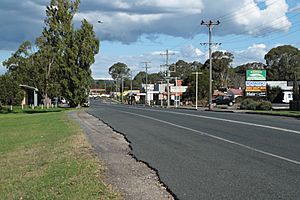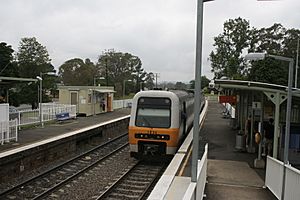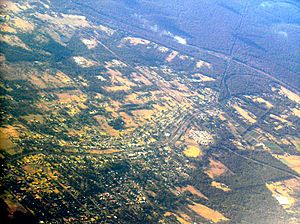Bargo, New South Wales facts for kids
Quick facts for kids BargoNew South Wales |
|||||||||||||||
|---|---|---|---|---|---|---|---|---|---|---|---|---|---|---|---|
| Population | 4,393 (2016 census) | ||||||||||||||
| Postcode(s) | 2574 | ||||||||||||||
| Elevation | 338 m (1,109 ft) | ||||||||||||||
| Location |
|
||||||||||||||
| LGA(s) | Wollondilly Shire | ||||||||||||||
| Region | Macarthur | ||||||||||||||
| State electorate(s) | Wollondilly | ||||||||||||||
| Federal Division(s) | Hume | ||||||||||||||
|
|||||||||||||||
Bargo is a town in the Macarthur Region of Sydney in New South Wales, Australia. It is part of the Wollondilly Shire. You can find Bargo about halfway between Campbelltown and Bowral. It is about 100 kilometers (62 miles) southwest of the center of Sydney.
The town is located between Tahmoor to the north and Yanderra to the south. You can reach Bargo easily using the Hume Highway. This highway connects Sydney, Canberra, and Melbourne. In the past, Bargo was known as West Bargo and also Cobargo.
Contents
Bargo's Early History and Name Origins
The name Bargo might come from an Aboriginal language word. This word, Barago, could mean "cripple," "thick scrub," or "brushwood." The first time Barago was written down was in 1807. George Caley mentioned it in a letter to Sir Joseph Banks.
The Aboriginal people called the Bargo area Narregarang. This name meant that the soil was not firm, like a shaky place. Caley's Aboriginal guide, Mowatiin, said the area's name meant "place of cliffs" or "thick shrubs."
Exploring the "Bargo Brush"
Early explorers and convicts found it hard to travel through the Bargo area. This was because of the very thick bush, which they called the "Bargo Brush." In early colonial times, the Bargo Brush became famous. It was known for hiding convicts who had escaped and become bushrangers.
Bargo is also special because it's where Europeans first saw some unique Australian animals. These animals include the lyrebird, the koala, and the wombat.
Community Facilities in Bargo
Bargo has many useful facilities for its community. These include places for sports and everyday needs.
Bargo Railway Station History
The Bargo railway station first opened on July 19, 1919. It was originally called West Bargo. In 1921, its name changed to Bargo. This station is part of the Main South Line. It is served by NSW TrainLink's Southern Highlands Line. The first station building was sadly destroyed by fire. Now, a temporary building is used.
Sports and Commercial Facilities
Bargo has a racetrack, tennis courts, and sports fields. There is also a skate park for everyone to enjoy. For shopping and services, Bargo has a hotel and a motel. You can also find a post office and a sports club. There are two small grocery stores, a chemist, and a bakery. Other businesses include a butcher, newsagent, and liquor store. You can also find restaurants, takeaway food, and a petrol station. There are car mechanics and hairdressing salons too. A public toilet is available in the park.
Important Heritage Sites in Bargo
Bargo has several places that are important for their history. These sites are protected because of their heritage value.
- Avon Dam Road: Nepean Dam
- Hume Highway: Wirrimbirra Sanctuary
- Main Southern railway 96.265 km: Bargo railway viaduct
Where is Bargo Located?
The town of Bargo has clear borders. It starts from Bargo River Road and goes south along the Bargo River. Then it goes to Tylers Road and along Silica Road to Remembrance Drive. From there, it goes north along the freeway to Dwyers Road. Finally, it goes north along Arina Road and back to the Bargo River.
Bargo's Population Facts
In 2016, a census was taken to count the people in Bargo. Here are some interesting facts about the population:
- There were 4,393 people living in Bargo.
- About 3.4% of the people were Aboriginal and Torres Strait Islander people.
- Most people (82.6%) were born in Australia. The next largest group (4.5%) was born in England.
- About 89.2% of people spoke only English at home.
- The most common religions were Anglican (28.9%), Catholic (28.0%), and No Religion (22.6%).
Fun Attractions and Local Businesses
Bargo offers many natural attractions and local businesses. These are great for families and visitors.
Exploring Local Dams
The Avon and Nepean Dams are popular places to visit. They are perfect for family picnics. You can also see the local water catchments and beautiful bushland there.
Wirrimbirra Sanctuary for Wildlife
Bargo is home to the Wirrimbirra Sanctuary. Thistle Yolette Harris started this animal reserve in the 1960s. It has lovely bushland walks on well-kept tracks. The sanctuary also offers programs to learn about plants and animals. There's a small café and a special animal pen where you can see wallabies up close.
Mermaid Pools and The Potholes
Mermaid Pools and The Potholes are found on the Bargo River. They are open for the public to enjoy swimming. Mermaid Pools was once a sacred site for Aboriginal women. It is believed to be protected by spirits. The Potholes, located nearby, have been a popular spot for summer swimming for a long time. They are still a favorite place for local residents. The Bargo Brush is a rare type of shrub. It grows mostly in the Bargo area, especially around Mermaid Pools.
Australian Wildlife Sanctuary
The Australian Wildlife Sanctuary is located on Remembrance Drive. This sanctuary is home to many native animals. You can see wombats, wallabies, and quokkas. There are also lizards, pythons, turtles, emus, and parrots. Please note that this sanctuary is currently closed.
Community Organizations in Bargo
Bargo has several active community organizations. These groups help bring people together and serve the area.
Wollondilly AFL Club
Australian Football started in Bargo in 1982. The Wollondilly Junior Australian Football Club, called The Cygnets, had teams for ages 9 to 15. They played in the Greater West Sydney Competition. Later, in 1989, the Wollondilly Senior Australian Football Club, The Knights, was formed. Both junior and senior clubs now play their home games at Hannaford Oval in Wilton.
Yerrinbool-Bargo Bushrangers Football
Bargo is home to the Yerrinbool-Bargo Bushrangers football team. This team was started by a group of men at the local pub. The Bushrangers now have teams from Under 6 to All Age Men and Women. They compete in the Highlands Competition. It's interesting that this team combines two places from different regions. Yerrinbool is in the Southern Highlands. Bargo is part of the Macarthur Region.
Bargo Rural Fire Brigade
The Bargo Rural Fire Brigade was started in 1939. They began with just a few hand tools and a drum of water. Today, they have modern equipment like pumpers and tankers. Their station is a special purpose-built building. The brigade helps fight fires in buildings and bushfires. They also respond to car accidents on the Hume Highway. The Bargo Fire Brigade also helps with big disasters outside their area. For example, they helped during the 1994 Sydney Bushfires and the 1999 Sydney Hail Storm. They celebrated 70 years of service in 2009.
Bargo Yanderra Tennis Association
The Bargo Yanderra Tennis Association has recently improved its facilities. They have new court surfaces. They are currently running a competition between their club and the Thirlmere tennis club. Ladies' social competitions are usually held on Tuesdays during school terms.





